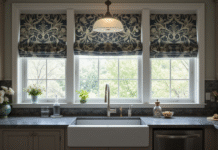Last Updated on April 4, 2022 by rida
Did you know that natural light could make you happier, improve your appetite, and reduce depression symptoms? Even more surprising is the fact that the intensity of lighting can affect your emotions and ability to make decisions. When it comes to interior lighting, you need to consider the space, ambiance, and atmosphere in each room.
For instance, bright lighting can affect your sleeping ability and encourage sleeping disorders, making dimmer and softer lights most preferable for bedrooms.
So, how do you plan your interior lighting? In this guide, we’ll look at some of the most helpful tips that’ll help you light your home the best way possible.
Table of Contents
1. Make a Lighting Plan
If you’re designing a home and need to start your interior lighting plan from scratch, there’s a wide array of considerations to make. Start by considering what activities take place in every room. Think about things like relaxing, working out, eating, and various activities.
Apart from activities, think about the key features of each room, such as space, scale, output, and layout, before you choose appropriate interior lighting. What architectural boundaries do you need to consider before choosing lighting fixtures? Here are several more considerations to make.
2. The Function of Each Room
The function of each room is one of the most important things to consider. When designing a home, think about how you are going to use the space in order to install suitable lighting options. For instance, when it comes to the sitting room area, you may want to install subtle lighting that induces a relaxing mood.
When it comes to kitchen or dining areas, go with practical lighting that needs to illuminate specific points like your workstation. If you have a large space, consider installing different interior lighting treatments at various junctures in order to delineate specific functions. This lighting plan is particularly useful in an open-plan room where the sitting, dining, and kitchen areas are in the same place and need flexible lighting options.
3. Think About the Mood of Each Room
The next thing to consider is the kind of mood you’d like to create in each room. Are you looking for contemporary sophistication, a cool atmosphere, a reflective calm, warm and cozy, or a romantic feeling? Maybe you want one of your rooms to be bright, lively, and stimulating with a sense of drama.
Interior lighting will have a great impact on whatever mood you want to create in each room. One of the best things about this consideration is that you’ll narrow down what you want. Even better, this planning phase will help you eliminate what you don’t want.
4. Consider Natural Light
Natural light has indisputable benefits on your health, and you need to make serious considerations for it when designing a home. It’s always suitable to strategically place large windows in certain spaces of your home to allow as much natural light as possible.
Apart from large windows, you could also install skylights in rooms that can’t accommodate the large windows.
Of course, with large windows, you have to consider drapes and blinds to control lighting when necessary. Beyond that, you can also think about other types of natural light, such as fireplaces that can make your home look warm, cozy, and inviting.
5. The Size of the Room Matters
When designing a home, take into account the dimensions of each room before you make commitments to interior lighting design. This means that if you’re looking to install large lighting chandeliers, the room should have enough space with a tall ceiling height to accommodate the kind of design you like. Think about the size of the room before choosing the best lighting fixtures.
6. Layer Your Lighting
A lot of professionals advise taking a layering approach when lighting a home. Layering your lighting involves using different light sources across different levels to create interest and ambiance in a room. Use interior lighting to make the most of your space, depending on the size and shape of the room.
For instance, you can use certain types of lighting to make a room seem larger or smaller. You can hang pendants that could create an illusion of heights or use a cluster of lighting to make a room feel cozier.
7. Choose Your Bulbs Carefully
You should put careful thought into the bulbs if you want to end up with the best home lighting. To choose appropriate bulbs, start by considering how bright you want the space to be in terms of watts. There’s a wide array of bulbs out there for every function, so don’t let this be an afterthought.
From here, think about the atmosphere you’re trying to achieve in terms of color and temperature, consider energy efficiency, and how frequently you need to use the lights. Beyond that, it’s of absolute importance that you consider whether you’re trying to make a focal or design statement when it comes to the colors, scale, and shape of your bulbs.
8. Use Spotlights To Highlight Favourite Features
If you have favorite features or spots in your home, you would like to highlight, use spotlights to bring them into focus. It could be a feature wall, a key position, or an architectural element that you want to highlight. Wall-mounted lights, for instance, will not only add warmth but elegance and sophistication to a room.
9. Think Carefully About Night Light
Midnight bathroom breaks can be worse with harsh lighting. It causes temporary blindness the minute you flip that switch. Consider installing directional floor level lighting on the way to the bathroom, in hallways, and on staircases to create subtle warmth and a guide.
10. Less Is Certainly More
When it comes to interior lighting, less is more to keep the color scheme, theme, and material finishes consistent. If you install too many different styles throughout your home, it could be confusing to your eyes and cause uneasiness.
Consider what areas you want to install dark use to add a sense of luxury and coziness and where you want to add pops of color through lampshades to add interest. Think of the most appropriate areas for neutral and lighter tones to open up the space.
Interior Lighting: Must-Know Tips
When planned correctly, interior lighting can be a piece of cake to pull off. Make every consideration in advance when designing a home, and you can be sure you’ll end up with appropriate lighting.
Beyond that, if you like this post, please check out our website for more.
Read more:Lighting Trends to Enhance Home Interior



























